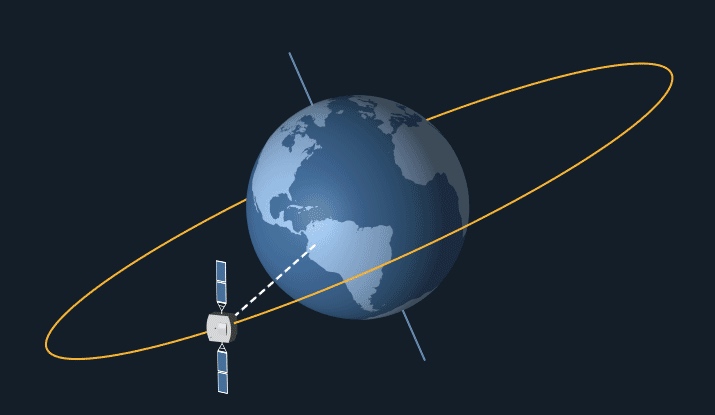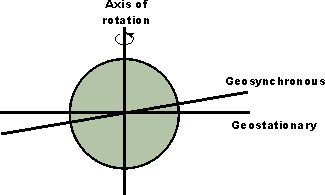Examples of how to use “geosynchronous orbit” in a sentence from the Cambridge Dictionary Labs. Geosynchronous orbit. Orbit around Earth of a satellite with an orbital period that matches Earth's rotation on its axis, which takes one sidereal day (about 23 hours, 56 minutes, and 4 seconds). Circular geosynchronous orbit 35786 km above Earth's equator.
- >Education
- >For Students
- >Grades 5-8
- >In the Spotlight
- Send

Student Features
Text Size
| Satellite in Orbit. |
From Earth, a satellite in geosynchronous orbit appears to 'hover' over one spot on the Equator. This helps the receiving dish on the ground. It can get information from the satellite by pointing at just one point in the sky. It doesn't have to move, or 'track,' the satellite across the sky.

The satellite isn't motionless, though. It's in a very high orbit and circles the Earth once a day. This orbit makes the satellite travel at the same rate as the Earth's spin.
There are many satellites currently in geosynchronous orbits. The weather satellite pictures (GIF, 60k) we see on the news come from these satellites. They constantly send pictures and information to receiving dishes on Earth. The GOES weather satellites are an example of this type of satellite. (Visit the GOES Weather Imagery Site). Most cable TV channel signals are also sent around the world with these types of satellites.NASA also uses geosynchronous satellites to send communications and data back and forth between spacecraft, such as the Space Shuttle and the Hubble Space Telescope, and control centers on Earth.Northrop Grumman’s second robotic life extension spacecraft docked with an Intelsat satellite in geosynchronous orbit Monday, the first link-up between a commercial servicing mission and an operational communications craft.

The two commercial satellites connected more than 22,000 miles (nearly 36,000 kilometers) over the equator at 1:34 p.m. EDT (1734 GMT) Monday, according to Northrop Grumman.
Northrop Grumman’s second Mission Extension Vehicle, known as MEV 2, glided to a smooth docking with the Intelsat 10-02 communications spacecraft.
“Today’s successful docking of our second Mission Extension Vehicle further demonstrates the reliability, safety and utility of in-space logistics,” said Tom Wilson, vice president of strategic space systems at Northrop Grumman and president of SpaceLogistics LLC. “The success of this mission paves the way for our second generation of servicing satellites and robotics, offering flexibility and resiliency for both commercial and government satellite operators, which can enable entirely new classes of missions.”
SpaceLogistics LLC, the company that sells MEV services, is a wholly-owned subsidiary of Northrop Grumman, which built the Mission Extension Vehicles.
The successful docking Monday followed a link-up between Northrop Grumman’s first satellite servicing spacecraft and a different Intelsat satellite in February 2020. That docking occurred in a so-called geosynchronous “graveyard” orbit about 180 miles (290 kilometers) above the belt of operational geosynchronous satellites.
Northrop Grumman’s first Mission Extension Vehicle docked with the Intelsat 901 satellite, which was deactivated and maneuvered away from other active geosynchronous satellites for the first-of-its-kind link-up with a servicing spacecraft.
The connection of the MEV 1 and Intelsat 901 satellites marked the first docking between two commercial satellites, and the first known link-up near geosynchronous orbit.
After meeting up with the Intelsat 901 satellite, Northrop Grumman’s MEV 1 spacecraft used its own propulsion to move Intelsat 901 from a position over the Pacific Ocean to a new operating location over the Atlantic. MEV 1 also nudged Intelsat 901 back over the equator from its earlier orbital inclination of 1.6 degrees.
With the boost from the MEV 1 servicer, Intelsat reactivated Intelsat 901 for communications services last April.
Satellites in geosynchronous orbit circle Earth at the same rate of the planet’s rotation. From the point-of-view of a user on the ground, a geosynchronous spacecraft remains in a fixed position in the sky, making the high-altitude orbit a popular location for communications satellites.
Armed with the experience of the MEV 1 docking, mission managers decided to orchestrate the docking of the MEV 2 spacecraft with its Intelsat client satellite in the belt of active geosynchronous satellites. The Intelsat 10-02 satellite remained in its operating position over the Atlantic Ocean and continued providing communications services as MEV 2 approached.
MEV 2 launched from French Guiana last August aboard a European Ariane 5 rocket.
Ground teams commanded Intelsat 10-02 into a “quiescent” mode before the MEV 2 spacecraft made its final approach.
In the final phase of the automated rendezvous, the servicing satellite extended a stinger into the main engine nozzle on Intelsat 10-02, which has not used its main thruster since the weeks after the satellite’s launch in 2004. Mechanical fingers then reached out and grabbed the target craft to pull the two satellites together.
Like the MEV 1 rendezvous last year, the MEV 2 spacecraft made several approaches to its Intelsat target satellite before moving in for docking. In one of the rendezvous approaches earlier this year, the Intelsat 10-02 satellite was not behaving as expected when it went into quiescent mode, so ground controllers commanded MEV 2 to back away while engineers reassessed the situation, an industry source said.
With the MEV 2 spacecraft successfully docked, the Intelsat 10-02 satellite will resume operations to beam broadband and other communications services across Europe, the Middle East, Africa, and South America.
“Intelsat has pioneered innovations in space-based technology for more than five decades,” said Mike DeMarco, Intelsat’s chief services officer. “We are proud to work side by side with Northrop Grumman on today’s groundbreaking mission, the first-ever docking of a communications satellite in GEO orbit.
“Space servicing is a valuable tool for Intelsat in extending the high-quality service experience that our customers depend upon,” DeMarco said in a statement. “Northrop Grumman’s MEV technology has helped us extend the life of two high-performing satellites, while focusing our innovation capital on advancing the Intelsat next-generation network — this technology is a ‘win-win’ for us.”
MEV 2 will provide five years of life extension services for the Intelsat 10-02 satellite, which is nearing the 17th anniversary of its launch. Intelsat 10-02 was built in Europe by Astrium, now part of Airbus, and had a 13-year life expectancy when it launched in 2004 aboard a Russian Proton rocket.
Geosynchronous Satellite Map
While Intelsat 10-02 is still healthy and providing services, the satellite is running low on propellant. MEV 2’s ion thrusters will take over propulsion to point the Intelsat spacecraft and maintain its orbit during the five-year servicing period.
Intelsat 10-02 carries C-band and Ku-band communications payloads. The Norwegian telecom company Telenor owns about half of the satellite’s Ku-band payload to broadcast hundreds of TV channels to households across Europe.
Northrop Grumman and SpaceLogistics do not plan to build and launch any more Mission Extension Vehicles. Once the MEV 1 and MEV 2 spacecraft finish their work with the two Intelsat satellites, they could move on to dock with other spacecraft to extend their missions.
DARPA, the Pentagon’s research and development agency, announced last year that it selected SpaceLogistics to demonstrate an advanced satellite servicing craft called the Mission Robotic Vehicle, or MRV. The MRV will be fitted with two DARPA-provided robotic arms and other tools that can repair other satellites in orbit, assemble structures in space, and upgrade customer spacecraft, in addition to the propulsive life extension services provided by the MEV.
Northrop Grumman says MRVs will also be able to mount life extension propulsion pods directly onto aging satellites, then move to another client rather than remaining docked for years at a time.
Geosynchronous Orbit Moon
Other companies are also pursuing satellite servicing and repair demonstration missions.
Maxar, a competitor with Northrop Grumman the satellite manufacturing business, is developing the Restore-L satellite servicing demonstration mission under contract to NASA that aims to refuel a Landsat Earth-imaging satellite, which orbits around 50 times closer to Earth than the geostationary altitude targeted by the the MEV.
Email the author.
Geosynchronous Orbit Ksp
Follow Stephen Clark on Twitter: @StephenClark1.
